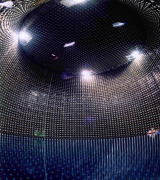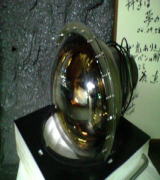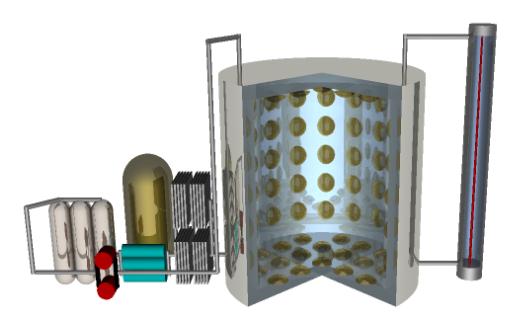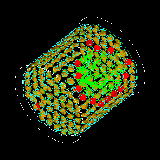Neutrinos from Supernova Explosion
Our team searches for neutrinos from supernova explosions at Super-Kamiokande in collaboration with Institute of Cosmic Ray Research, University of Tokyo. The neutrinos from Supernova explosion were detected first by Professor Masatoshi Koshiba by detecting 12 neutrinos from 1987A, which led to his Nobel Prize in Physics in 2002. A basic mechanism of the Supernova explosion, which is called a mini Big-Bang, was shown to be right. But, how the gravitational collapse of a heavy star proceeds to the Supernova explosion is still unknown. Super-Kamiokande can detect about 10K neutrinos over 10 seconds from the next Supernova explosion in Our Gallaxy and it is expected to clarify the mechanism. Further, we currently develop the world’s most sensitive detector to anti-electron neutrinos utilizing Gadolinium. Anti-electron neutrinos from Supernova explosion have the largest cross section off water target. Supernova explosions can scatter heavy elements throughout the Universe, and these heavy elements then become the foundations of stars, planets and Earth. Detecting neutrinos from supernova explosions can also give us insights on the creation of matter in the history of Cosmos. We welcome students who are interested in astrophysics, neutrinos, and particle physics. Let’s study neutrinos from far away in the Cosmos together in our lab!
What is a neutrino?
 |
| Figure 1.Inside of the Super-Kamiokande detector. The wall is filled with 20-inch photomultiplier tubes. |
The world we live in is made up of elemental particles. These are particles which cannot be broken up into smaller pieces. An atom, for example, is made up of electrons and a nucleus. Each electron is an elemental particle, but the nucleus consists of protons and neutrons bound together. Each proton and neutron is made up of three quarks, and a quark is an elemental particle.
Oddly there exist elemental particles that rarely interact. Those particles are neutrinos. Interactions among fundamental particles occur through exchange of forces: gravitation, weak, electromagnetic and strong. Quarks are held together by strong forces to make a proton or a neutron, and a nucleon and electrons by electromagnetic force to form an atom. In a larger scale, we are held on Earth by gravitational force, and the earth itself is rotating around the Sun interacting gravitationally. On the other hand, neutrinos only interact weakly. This interaction means literally ‘weak’, and cannot make any binding state such as the ones stated earlier.
 |
| Figure 2.A 20-inch photomultiplier tube to detect a faint light signal at high sensitivity. |
Neutrinos are first mentioned by Wolfgang Pauli in 1930. They were introduced to fill the energy conservation of beta decays. Later in 1954, Frederick Reines and Clyde Cowan detected neutrino for the first time in history. This discovery led the pair to the Nobel Physics prize in 1995. Later researches have shown that there are six types of neutrinos, and they have very small but non-zero mass.
Our Research
Super-Kamiokande is the world’s largest particle detector, located below 1000 m of mountain in the central part of Japan (Fig. 1). The cylindrical shaped detector of 40 m in height and 42 m in diameter can enclose a ten-story building. The cylinder is filled with 50,000 tons of purest water. When a passing neutrino interacts inside of the detector, it creates a charged particle such as electron and muon. The fast travelling charged particle releases faint light called Cerenkov light. The light can be detected by 12,000 of the world’s largest 20-inch photomultiplier tubes installed fully on the wall.
 |
| Figure 3.A small-scale prototype detector: water transparency measurement system on the right and water purification system on the left. |
In 1987, a supernova explosion occurred in the Large Magellanic Cloud. Since then we haven’t observed any other supernovae in our galaxy nor in the nearby galaxies. The rate of an explosion happening in a galaxy is estimated once every 10 to 30 years. So we can expect one in a very near future. We must be ready to immediately detect neutrino burst from the supernova. Our team is in charge of the system for the real-time detection of the neutrino bursts and its maintenance and development. We also search for bursts which we may have missed by closely analyzing collected data.
Since the beginning of the Cosmos, there must have been supernovae occurring everywhere in it. The Universe should be full of remnants of these supernovae called relic neutrinos. Our team also aims to detect these neutrinos. We will be able to estimate the number of times supernovae occurred in the history of our Universe, once the relic neutrinos are detected and its flux is measured. Then we will be able to calculate the amount of heavy elements that constructs the earth. With data from Super-Kamiokande, we are already very close to the flux upper limit that theories predict. However, because of the events that look very similar to the relic neutrino events (background events), we won’t be able to improve our measurements. Thus our aim is to upgrade the detector by dissolving Gadolinium into the water and increase the sensitivity to anti-neutrino detection.
 |
| Figure 4. A simulated neutron capture event. |
We stated earlier that there were six types of neutrinos. Supernovae release all six types. Out of the six, anti-electron neutrinos most frequently interact with water (actually hydrogen nucleon, i.e., proton) which is the neutrino target at Super-Kamiokande. This interaction lets out a positron and a nucleon. Subsequently, the positron radiates Cerenkov light and can be detected. On the other hand, the neutron is hard to be detected by the current data acquisition system at Super-Kamiokande. The detection of this neutron then becomes a key to reduce the unwanted background events. Gadolinium has very high neutron absorption capability compared to other chemical elements, and also the energies of the gamma rays released after the capture are easily high enough for detection at Super-Kamiokande. In summary, neutron detection via Gadolinium can lead us to detect anti-electron neutrinos at unprecedented level of sensitivity. Our team is constructing a prototype gadolinium dissolved water Cerenkov detector in collaboration with Super-Kamiokande group in the Kamioka mine. We are also investigating the effects of gadolinium on the detector materials and constructing simulation tools for the detector with Geant4.
What can we learn from this reseach?
Super-Kamiokande has accomplished many achievements as water Cerenkov detector. With the addition of neutron detection capability, the detector performance will qualitatively improve. New technologies have sprung out along new detection ideas and developments.
You will gain knowledge of astrophysics, especially cosmology and star formation, and particle physics. You will experience and acquire experimental techniques for neutrino detection and construction of data analysis software.
If you are interested in the cosmos, elemental particles and neutrinos, come and visit our lab. Let’s study frontier science and develop cutting-edge technologies together in our lab!